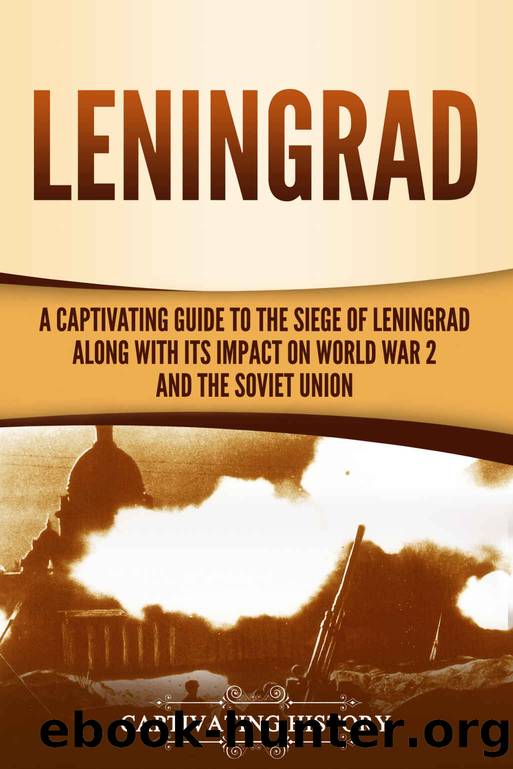Leningrad: A Captivating Guide to the Siege of Leningrad and Its Impact on World War 2 and the Soviet Union by Captivating History

Author:Captivating History [History, Captivating]
Language: eng
Format: azw3
Published: 2020-07-24T00:00:00+00:00
Illustration 10: Govorov, who was considered a master in the use of artillery, at the warâs end.
Chapter 6 â The Battlefield
During the 900 Days, hundreds of battles, large and small, took place. For the soldiers of the Wehrmacht and the Red Army, many of whom remained in the area throughout the siege, time lost meaning, perhaps only noticed when the seasons changed. The winters in Russia were cold, brutally so. Fall and spring were temperate for the most part, but those months were often filled with rain, which often turned the battlefield, trenches, and roads into a sea of unbelievably sloppy, deep mud. Summer was tolerable, except that in the Far North, summer, especially in those areas near water, was a time for swarms of mosquitoes that literally made it difficult to breathe.
For the Germans, as well as the Soviet citizens within Leningrad, the worst time, obviously, was winter. The war years saw some of the coldest winters of the 20th century throughout Europe, and in Russia, it was far worse. As many people know, the German Army was woefully unprepared for the Russian winter.
There are two main reasons for this. Firstly, the Russian winter has to be experienced, and though one can read about it in a book (which Hitler obviously did not do, according to a speech by British Prime Minister Winston Churchill), nothing can prepare a person for -40ºF temperatures. Think about that for a moment: on a day when itâs 40ºF outside in the morning, one wears a sweater and perhaps a coat and jacket. If the temperature rises by thirty degrees, a person might wear a short-sleeved shirt and shorts. But, if itâs -40ºF and the mercury rises by thirty degrees, itâs still -10ºF!
Secondly, the German command, beginning with Hitler, expected and prepared for a quick victory, and in the first weeks of the battle, it seemed they were right. But as you have read, the Soviet resistance stiffened, and the Germans were stopped outside Leningrad in September and Moscow in November.
It should be mentioned, though, that although it is true that the Soviets were better prepared for the cold than the Germans, that doesnât mean they didnât suffer as well. Frostbite was a killer of thousands of men (and women and children in the city) on both sides. Soviet soldiers, especially in that first year of the war, suffered from a shortage of proper boots, gloves, and parkas. In the city, things were worse.
In the rest of this chapter, we will take you through the major military events of the siege. In the following chapters, you will read about the suffering of those inside the city and the efforts of the Soviets to relieve that suffering.
The first attack on Leningrad came on the day after Operation Barbarossa began when the Germans sent a wave of Junkers 88 medium bombers over the city. Little damage was done, and the Soviets scored a propaganda victory when one of the bomber crews was forced to make an emergency landing within the Soviet defensive ring.
Download
This site does not store any files on its server. We only index and link to content provided by other sites. Please contact the content providers to delete copyright contents if any and email us, we'll remove relevant links or contents immediately.
The Light of Days by Judy Batalion(836)
Stalin's War: A New History of World War II by Sean McMeekin(693)
The Pacific War 1941-1943 by James Holland(621)
Walk in My Combat Boots by James Patterson(618)
Victory's Price (Star Wars) by Alexander Freed(591)
The Vietnam War: An Intimate History by Geoffrey C. Ward & Ken Burns(575)
First Platoon: A Story of Modern War in the Age of Identity Dominance by Annie Jacobsen(569)
The American War in Afghanistan by Carter Malkasian(564)
Cold War (Alexander King Book 2) by Bradley Wright(560)
Operation Pedestal by Max Hastings(554)
Blood and Ruins: The Great Imperial War, 1931-1945 by Richard Overy(542)
Concepts of Space by Jammer Max;(526)
The Madman Theory by Jim Sciutto(526)
Extreme Fitness by Chris McNab(520)
Flying Tiger by Samson Jack(508)
World War II Infantry Fire Support Tactics by Gordon L. Rottman(507)
Pathfinders by AL-KHALILI JIM(499)
Panzerkrieg by Mike Syron(492)
Hitler’s Pre-Emptive War: The Battle for Norway, 1940 by Henrik O. Lunde(488)
